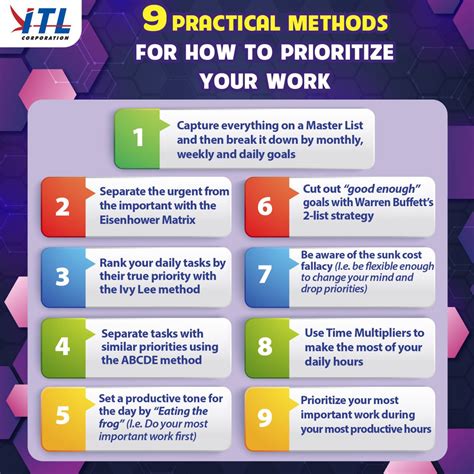In today's fast-paced world, managing your time effectively is crucial for achieving your goals and maintaining a healthy work-life balance. By implementing powerful strategies and adopting smart techniques, you can significantly improve your productivity and make the most out of the 24 hours in a day.
Discover the key to unlocking your full potential and reaching new heights of efficiency. Prioritizing tasks, avoiding distractions, and optimizing your workflow are just a few of the essential elements that will be explored in this comprehensive guide.
Enhance your time management skills and revolutionize the way you approach work and daily responsibilities. Whether you're a busy professional, a student, or an entrepreneur, the tips and tricks shared in this article will empower you to accomplish more in less time and free up valuable moments for relaxation and personal growth.
Prioritize Your Tasks Effectively

In a fast-paced world where time is of the essence, it is crucial to have a system in place to prioritize your tasks effectively. By determining the importance and urgency of each task, you can ensure that your valuable time is spent on the most vital and meaningful activities.
One technique to prioritize your tasks is to categorize them based on their significance and the impact they have on your goals. Assigning different levels of priority to each task allows you to focus on the ones that align with your objectives and contribute the most towards your success.
Another effective way to prioritize your tasks is by considering their deadlines and time sensitivity. Some tasks may require immediate attention, while others can be scheduled for a later time. By understanding the time constraints associated with each task, you can allocate your resources accordingly and avoid last-minute rushes.
Additionally, it is essential to consider the dependencies between tasks. Some tasks may rely on the completion of others, and prioritizing accordingly ensures a smoother workflow and prevents bottlenecks. Identifying the interrelationships between tasks allows you to create a logical sequence and avoid unnecessary delays.
Remember to take into account your personal energy levels and productivity patterns when prioritizing tasks. Certain activities may require more mental or physical exertion, and scheduling them during your peak performance times can increase efficiency and effectiveness. By aligning your energy levels with the tasks at hand, you can optimize your productivity and make the most of your available time.
In conclusion, effectively prioritizing your tasks is a critical aspect of time management. By categorizing tasks based on significance, considering deadlines and dependencies, and aligning your energy levels, you can maximize your productivity and achieve your goals in a timely manner.
Set Clear and Achievable Goals
Enhance your effectiveness and make the most of your time by setting clear and attainable objectives. By defining what you want to achieve, you can prioritize your tasks and focus your energy on the most important and relevant activities.
Clarify Your Objectives: Start by identifying your desired outcomes and understanding the purpose behind your actions. Clearly define what you want to accomplish and why it matters to you. This clarity will guide your decision-making and help you stay motivated as you work towards your goals.
Break It Down: Once you have established your overall objectives, break them down into smaller, manageable tasks. Break your goals into specific action steps, and create a timeline with deadlines to keep yourself accountable. This division will make your goals more attainable and enable you to track your progress effectively.
Set Realistic Expectations: While it is essential to challenge yourself, it is equally important to set realistic expectations. Setting unattainable goals can lead to disappointment and frustration, hindering your overall productivity. Be honest with yourself about your capabilities and consider external circumstances that may impact your progress.
Stay Focused: To improve your time management skills, remain focused on your objectives and avoid distractions. Prioritize tasks that directly contribute to your goals and limit time spent on non-essential activities. Practice self-discipline and use strategies like time blocking or the Pomodoro Technique to maintain your concentration and avoid procrastination.
Celebrate Milestones: Acknowledge and celebrate your achievements along the way. When you reach significant milestones or complete a task successfully, take a moment to reflect on your progress and reward yourself. Recognizing your accomplishments will not only boost your motivation but also provide a sense of satisfaction, further fueling your productivity.
In conclusion, setting clear and achievable goals is a fundamental aspect of effective time management. It enables you to prioritize tasks, track your progress, and maintain focus on what truly matters. By breaking down your objectives, setting realistic expectations, and celebrating milestones, you will enhance your productivity and ultimately accomplish more in the limited time you have.
Breaking down large projects into smaller tasks

One effective strategy for managing your time and increasing productivity is to break down big projects into smaller, more manageable tasks. By dividing a large project into smaller components, you can better understand the overall scope and make progress in a more organized and efficient manner.
- Task Identification: Start by identifying all the tasks involved in the project. Breaking down the project into specific and actionable tasks will provide a clear roadmap for your progress.
- Work Prioritization: Evaluate the importance and urgency of each task and prioritize them accordingly. This will help you focus on the most critical tasks and ensure that you allocate your time effectively.
- Time Estimation: Estimate the amount of time required for each task. This will assist you in creating a realistic schedule and allow you to allocate your time more efficiently.
- Task Sequencing: Determine the logical sequence of tasks. Identify any dependencies or relationships between tasks and arrange them accordingly to ensure smooth progress and avoid bottlenecks.
- Task Delegation: If applicable, consider delegating certain tasks to others. Delegating tasks can help distribute the workload, increase efficiency, and allow you to focus on high-priority tasks.
- Monitoring and Evaluation: Regularly monitor your progress and evaluate the completion of each task. This will help you stay on track, identify any potential issues, and make adjustments if necessary.
By breaking down big projects into smaller tasks, you can overcome the overwhelm and increase your productivity. This approach allows for better planning, organization, and focus, enabling you to make steady progress towards accomplishing your goals.
Eliminate Distractions and Focus on One Task at a Time
In today's fast-paced world, staying focused and productive can be a challenge. With the constant bombardment of notifications, emails, and social media updates, it's easy to get distracted and lose sight of your priorities. However, by eliminating distractions and honing your ability to focus on one task at a time, you can significantly boost your efficiency and achieve better results.
Minimize Interruptions: It's crucial to create an environment that fosters concentration. Find a quiet space where you can work without interruptions, whether it's a designated workspace or a pair of noise-canceling headphones. Consider turning off notifications on your phone and computer to prevent constant interruptions.
Practice Single-Tasking: Multitasking is often seen as a valuable skill, but research has shown that it actually reduces productivity. Instead, focus on one task at a time. Prioritize your to-do list and work on the most important tasks first. By giving your full attention to each task, you'll be able to complete them more efficiently and produce higher quality work.
Set Clear Goals: Without clear goals and deadlines, it's easy to get sidetracked and lose motivation. Create specific, measurable, achievable, relevant, and time-bound (SMART) goals for each task or project. Break them down into smaller, manageable steps, and track your progress regularly. This will help you stay focused and maintain a sense of purpose.
Manage Email and Social Media: Email and social media can be major time-wasters if not managed properly. Limit the time you spend checking and responding to emails by scheduling specific times dedicated to this activity. Consider using productivity tools that can help you manage your inbox more efficiently. Similarly, set boundaries for your social media usage and avoid mindless scrolling during work hours.
Practice Mindfulness: Cultivating a habit of mindfulness can greatly enhance your ability to eliminate distractions and stay focused. Take regular breaks to clear your mind and recharge. Incorporate mindfulness techniques such as deep breathing or meditation into your routine to improve your concentration and reduce stress.
By implementing these strategies and making a conscious effort to eliminate distractions, you'll be able to improve your ability to focus on one task at a time. This heightened focus will lead to increased productivity, better time management, and ultimately, more successful outcomes.
Delegate and Outsource Non-Essential Tasks

Streamlining your workload is essential for maximizing productivity. One effective way to achieve this is by delegating and outsourcing non-essential tasks.
When you delegate tasks, you assign them to someone else who is capable of completing them. This not only lightens your workload but also allows you to focus on high-priority and more important tasks. Delegating empowers your team members, fosters their growth, and promotes a sense of shared responsibility.
- Identify tasks that do not require your expertise or direct attention.
- Analyze the skills and capabilities of your team members or colleagues.
- Communicate clearly and provide instructions or guidelines for delegated tasks.
- Establish checkpoints to monitor progress and provide feedback along the way.
Outsourcing non-essential tasks takes delegation a step further by involving external resources or freelancers. This strategy allows you to tap into specialized skills and expertise without the need for in-house resources. Outsourcing can be particularly beneficial for tasks that are time-consuming or outside the scope of your core business activities.
- Identify the tasks that can be effectively handled by external resources.
- Research and select reputable outsourcing partners or freelancers.
- Clearly communicate your expectations, deadlines, and deliverables.
- Establish open lines of communication and regular updates with the outsourced party.
- Review the quality of work delivered and provide feedback for improvement if necessary.
By delegating and outsourcing non-essential tasks, you free up valuable time and mental energy to focus on what truly matters. Embracing these practices will allow you to streamline your productivity and make the most of your resources.
Streamline Your Workflow with Technology Tools
In today's fast-paced world, incorporating technology tools into your daily routine can greatly enhance your efficiency and effectiveness. By harnessing the power of technology, you can optimize your workflow, eliminate repetitive tasks, and focus on high-value activities that drive your productivity.
Automation: One of the key benefits of using technology tools is the ability to automate time-consuming and repetitive tasks. By leveraging automation software or apps, you can streamline your workflow by eliminating manual data entry, scheduling appointments, or sending routine emails. This allows you to dedicate more time and energy to tasks that require your expertise and creativity.
Collaboration: Technology tools also play a crucial role in facilitating collaboration and communication among team members. Whether you are working on a project remotely or in a shared workspace, utilizing tools such as project management software, file-sharing platforms, or instant messaging apps can enhance team productivity and efficiency. These tools enable seamless communication, real-time updates, and centralized access to resources, eliminating the need for lengthy email threads or physical document exchanges.
Organization: Keeping track of commitments, deadlines, and priorities is vital in managing your time effectively. Technology tools provide a myriad of options to help you stay organized. From digital calendars and task management apps to note-taking tools and virtual sticky notes, these resources can assist you in structuring your day, setting reminders, and prioritizing tasks. This ensures that you stay on top of your responsibilities and make efficient use of your time.
Data Analysis: Technology tools also empower you to analyze and optimize your productivity. By utilizing time-tracking apps, productivity trackers, or project management software with reporting capabilities, you can gain insights into how you spend your time, identify patterns, and make informed decisions to enhance your workflow. This data-driven approach allows you to identify bottlenecks, eliminate time-wasting activities, and allocate your resources more efficiently.
Incorporating technology tools into your workflow can revolutionize how you manage your time and boost your overall productivity. By automating repetitive tasks, fostering collaboration, enhancing organization, and leveraging data analysis, you can streamline your workflow and focus on activities that truly contribute to your success.
Implementing the Pomodoro Technique: Enhance Efficiency through Effective Time Control

Discover a proven approach to optimizing your time management skills and achieving higher productivity by incorporating the renowned Pomodoro Technique. This method allows you to efficiently allocate your time, concentrate on tasks, and maximize your overall output. By following this technique, you can enhance your focus, reduce distractions, and maintain a healthy work-life balance.
Enhance Your Efficiency by Incorporating Regular Breaks and Prioritizing Self-Care
One essential aspect of optimizing productivity in your daily routine involves taking regular breaks and ensuring self-care practices are prioritized. By allowing yourself designated periods of rest, you can effectively rejuvenate and recharge, enhancing your overall efficiency and focus. Emphasizing self-care activities further aids in maintaining a balanced mental, emotional, and physical state, which positively impacts productivity levels.
When it comes to maximizing productivity, it is crucial to recognize the significance of periodic breaks. These intervals allow individuals to step away from their work, providing an opportunity for mental relaxation and reducing the risk of burnout. Engaging in activities such as stretching, deep breathing exercises, or taking short walks stimulates blood circulation, improves focus, and revitalizes the mind. By integrating regular breaks into your schedule, you can sustain concentration and sustain productivity throughout the day.
Prioritizing self-care is equally important for optimal productivity. Practicing self-care involves engaging in actions that promote overall well-being, both physically and mentally. Activities such as meditation, journaling, participating in hobbies, or simply spending quality time with loved ones can significantly enhance productivity. These practices allow individuals to effectively manage stress levels, improve mental clarity, and foster a balanced mindset. Moreover, ensuring an adequate amount of sleep, maintaining a healthy diet, and staying hydrated, contribute to sustained energy levels and increased productivity.
In conclusion, by incorporating regular breaks and prioritizing self-care practices, individuals can achieve optimal productivity levels. Investing time in relaxation and self-care not only rejuvenates the mind but also enhances focus, mental clarity, and overall well-being. By valuing these practices and implementing them into your daily routine, you can experience heightened efficiency and achieve greater success in both personal and professional endeavors.
FAQ
What are some practical time management techniques that can help me boost my productivity?
Some practical time management techniques that can help boost productivity include prioritizing tasks, breaking larger tasks into smaller, manageable ones, setting clear goals and deadlines, minimizing distractions, and using tools such as to-do lists or productivity apps.
How can I prioritize tasks effectively to manage my time better?
To prioritize tasks effectively, start by identifying the most important and urgent tasks and tackle them first. Consider the deadlines, impact, and dependencies of each task. You can also use techniques like the Eisenhower Matrix, which categorizes tasks into four quadrants based on their urgency and importance.
What are some common distractions that hinder productivity and how can I minimize them?
Common distractions that hinder productivity include notifications from social media or messaging apps, excessive multitasking, noisy environments, or disorganized workspaces. Minimize distractions by turning off notifications, setting specific times for checking emails or social media, creating a designated workspace, using noise-cancelling headphones, and practicing single-tasking.
Are there any specific time management tools or apps that can help me become more productive?
Yes, there are various time management tools and apps available that can help increase productivity. Some popular ones include Todoist, Trello, Evernote, Google Calendar, and Pomodoro Technique apps. These tools help with task organization, setting reminders, time tracking, and managing deadlines.
How can I effectively break larger tasks into smaller, manageable ones?
To break larger tasks into smaller, manageable ones, start by identifying the main objective of the task. Then, brainstorm the necessary steps or subtasks needed to achieve that objective. Organize these subtasks in a logical order and assign realistic deadlines to each. This allows for better planning and makes the overall task less overwhelming.
What are some effective time management techniques to boost productivity?
There are several effective time management techniques to boost productivity. One technique is the Pomodoro Technique, where you work in short bursts of intense focus followed by short breaks. Another technique is prioritizing tasks using the Eisenhower Matrix, which helps you distinguish between urgent and important tasks. Additionally, setting clear goals, minimizing distractions, and delegating tasks can also enhance productivity.
How can I implement the Pomodoro Technique in my daily routine?
To implement the Pomodoro Technique in your daily routine, you can follow these steps. Firstly, choose a task you want to work on. Secondly, set a timer for 25 minutes (the Pomodoro time) and work with complete focus on the task during this time. Once the timer goes off, take a short break of 5 minutes. After four Pomodoro cycles, take a longer break of 15-30 minutes. This cycle helps you maintain productivity and avoid burnout.



